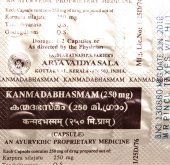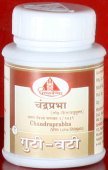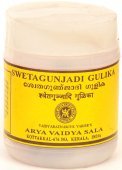Shilajatu, Śilājatu, Shila-jatu: 10 definitions
Introduction:
Shilajatu means something in Hinduism, Sanskrit, biology. If you want to know the exact meaning, history, etymology or English translation of this term then check out the descriptions on this page. Add your comment or reference to a book if you want to contribute to this summary article.
The Sanskrit term Śilājatu can be transliterated into English as Silajatu or Shilajatu, using the IAST transliteration scheme (?).
In Hinduism
Ayurveda (science of life)
Rasashastra (Alchemy and Herbo-Mineral preparations)
Source: Indian Journal of History of Science: Rasaprakāśa-sudhākara, chapter 4-5Śilājatu (Mineral pitch/asphalt/bituman):—According to other texts the Śilājatu is mainly of two types such as:—
- Gomūtra-gandhi
- and Karpūra-gandhi.
The first variety is again subdivided in two varieties such as Sasatva and Satvahīna; of the two the first one is better in properties and is capable of destroying all the doṣas.
Origin: In summer season due to intense heat a few rocks of Himalaya mountain containing either gold, silver or copper may start oozing an exudates from some rocks. That is known as Śilājatu and claimed to contain respective metals in it. (It has the following sub-varieties:)
- Hema-garbha-śilājatu:—The Śilājatu produced from the gold containing rocks is similar to bandhūkapuṣpa in colour i.e. (yellowish). It is heavy, oily or greesy and very cool in nature, acts as best Rasāyana, contains tikta and madhura-rasas, may pacifyall the doṣas.
- Raupya-garbha-śilājatu:—The Śilājatu produced from the silver containing rocks in pāṇḍura (whitish) in colour, madhura in rasa and cool in properties, may pacify pittaja-pāṇḍu and destroys kṣaya-rogas.
- Śulva-garbha-śilājatu:—The Śilājatu produced from the copper containing rocks is black in colour, almost solid and heavy in form and weight. It may pacify kapha and vāta-doṣas and can conquer all diseases.
- Loha-garbha-śilājatu:—(no separate description in this text).
If it is put on fire, it takes the shape of liṅga (penis); It burns without producing smoke; It should dissolve in water. Only such Śilājatu is considered as real or pure Śilājatu.
The man who always uses purified Śilājatu lives for hundred years ingood health and never suffers with any disease and these persons are never get affected with mūtrakṛccha and aśmarī etc. urinary disorders. Whatever properties have been found by the wise persons in Mahārasas, Uparasas, Dhātus, Ratnas and in Pārada or its compounds all those propertiesare claimed to be present in Śilājatu (Śilādhatu) also.

Āyurveda (आयुर्वेद, ayurveda) is a branch of Indian science dealing with medicine, herbalism, taxology, anatomy, surgery, alchemy and related topics. Traditional practice of Āyurveda in ancient India dates back to at least the first millenium BC. Literature is commonly written in Sanskrit using various poetic metres.
General definition (in Hinduism)
Source: WJPPS: Śilājatu (asphaltum): Traditional medicineŚilājatu is a thick, sticky tar like substance with a colour ranging from white to dark brown (later is more common). Śilājatu is blackish-brown exudation of variable consistency, obtained from steep rocks of different formations found in the Himalayas. The word ‘Śilājatu’ comprises of two terms, one ‘śilā’ and other ‘jatu’. The word Śilā denotes rock, which is considered as one of the most important source. Term Jatu denotes a blackish brown substance, which is similar to ‘lākṣā’. Thus ‘Śilājatu’ is the exudates of rocks having blackish brown colour and oozes out from steep rocks of mountain during summers because of intense sun heat.
On the basis of colour and smell Śilājatu is of two types:
-
Gomūtra Gandhi- it is blackish brown and the odour similar to cow’s urine. This variety is again divided in to two types:
- Sasatva- that contains metal (better varieties).
- Niḥsatva- that does not contain metal. On the basis of metallic contents Caraka and Suśruta have different views.
- Karpūra Gandhi- it is white and possess odour similar to camphor.
Caraka-saṃhitā describes four types viz. 1) Hema (gold), 2) Rajata (silver), 3) Tāmra (copper), 4) Kriṣnāyasa (iron).
Suśruta-saṃhitā along with Vāgbhaṭa, describes six types of Śilājatu viz. 1) Suvarna, 2) Rajata, 3) Tāmra, 4) Lauha, 5) Trapu/Vanga (Tin) and 6) Sīsaka/Nāga (Lead).
These varieties may be due to the presence of different metals in particular mountain from where Śilājatu is obtained. Of all the Śilājatu, one having the smell of cow’s urine is considered best for the therapeutic purposes. Lauha Śilājatu is considered best for Rasāyana therapy.
Origin: Mythologically, according to Cakradutta, Bṛhat-rasarājsundara and Rasendra-purāṇa, Śilājatu is supposed to have originated from the Mandrācala Parvata as Sveda while churning of the ocean. Further it is said that Śilājatu is distributed in the hilly areas and comes out of rocks on being exposed by intense sun heat. According to Caraka-saṃhitā, Suśruta-saṃhitā, Rasa-ratna-samuccaya and other important texts, during summer due to intense heat, Śilājatu exudates from the lower part of the Himalayan mountains.
Biology (plants and animals)
Source: Google Books: CRC World Dictionary (Regional names)Shilajatu in India is the name of a plant defined with Swertia decussata in various botanical sources. This page contains potential references in Ayurveda, modern medicine, and other folk traditions or local practices.
Example references for further research on medicinal uses or toxicity (see latin names for full list):
· The Flora of British India (1883)
If you are looking for specific details regarding Shilajatu, for example pregnancy safety, diet and recipes, health benefits, chemical composition, side effects, extract dosage, have a look at these references.

This sections includes definitions from the five kingdoms of living things: Animals, Plants, Fungi, Protists and Monera. It will include both the official binomial nomenclature (scientific names usually in Latin) as well as regional spellings and variants.
Languages of India and abroad
Sanskrit dictionary
Source: DDSA: The practical Sanskrit-English dictionaryŚilājatu (शिलाजतु).—n.
1) bitumen; निदाघे धर्मसंतप्ता धातुसारंधरा धराः । निर्यासवत् प्रमुञ्चन्ति तच्छिलाजतु कीर्तितम् (nidāghe dharmasaṃtaptā dhātusāraṃdharā dharāḥ | niryāsavat pramuñcanti tacchilājatu kīrtitam) || Bhāva P.
2) red chalk.
Śilājatu is a Sanskrit compound consisting of the terms śilā and jatu (जतु).
Source: Cologne Digital Sanskrit Dictionaries: Shabda-Sagara Sanskrit-English DictionaryŚilājatu (शिलाजतु).—n.
(-tuḥ) 1. Bitumen. 2. Red chalk. E. śilā a stone, and jatu lac; it is supposed to ooze from the stones of mountains in the hot weather.
Source: Cologne Digital Sanskrit Dictionaries: Benfey Sanskrit-English DictionaryŚilājatu (शिलाजतु).—n. 1. bitumen. 2. red chalk.
Śilājatu is a Sanskrit compound consisting of the terms śilā and jatu (जतु).
Source: Cologne Digital Sanskrit Dictionaries: Monier-Williams Sanskrit-English Dictionary1) Śilājatu (शिलाजतु):—[=śilā-jatu] [from śilā] n. ‘rock-exudation’, bitumen, [Mahābhārata; Suśruta] etc.
2) [v.s. ...] red chalk, [Horace H. Wilson]
Source: Cologne Digital Sanskrit Dictionaries: Yates Sanskrit-English DictionaryŚilājatu (शिलाजतु):—[śilā-jatu] (tu) 2. n. Bitumen; red chalk.
[Sanskrit to German]
Sanskrit, also spelled संस्कृतम् (saṃskṛtam), is an ancient language of India commonly seen as the grandmother of the Indo-European language family (even English!). Closely allied with Prakrit and Pali, Sanskrit is more exhaustive in both grammar and terms and has the most extensive collection of literature in the world, greatly surpassing its sister-languages Greek and Latin.
Kannada-English dictionary
Source: Alar: Kannada-English corpusŚilājatu (ಶಿಲಾಜತು):—
1) [noun] any of several hard or semisolid materials obtained as a tarlike residue in the distillation of petroleum, coal tar, wood tar, etc.; bitumen.
2) [noun] red chalk.
Kannada is a Dravidian language (as opposed to the Indo-European language family) mainly spoken in the southwestern region of India.
See also (Relevant definitions)
Partial matches: Shila, Jatu, Cila.
Starts with: Shilajatukalpa, Shilajatvadi.
Full-text (+22): Shilajatukalpa, Makkula, Calacattu, Gomutragamdhi, Jatvashmaka, Cilacattu, Upadhatu, Shiladadru, Ashmottha, Agaja, Nirdhuma, Shiladhatu, Sikthaka, Rasashastra, Ashmaja, Adrikanya, Shailasambhuta, Sarjaniryasaka, Sarjamani, Sarjarasa.
Relevant text
Search found 11 books and stories containing Shilajatu, Śilājatu, Silajatu, Shila-jatu, Śilā-jatu, Sila-jatu; (plurals include: Shilajatus, Śilājatus, Silajatus, jatus). You can also click to the full overview containing English textual excerpts. Below are direct links for the most relevant articles:
Rasa Jala Nidhi, vol 2: Minerals (uparasa) (by Bhudeb Mookerjee)
Part 1 - Characteristics of Shilajatu or Shilajit (bitumen) < [Chapter IV - Uparasa (4): Shilajatu or Shilajit (bitumen)]
Part 2 - Purification of shilajatu < [Chapter IV - Uparasa (4): Shilajatu or Shilajit (bitumen)]
Part 3 - Incineration of shilajatu < [Chapter IV - Uparasa (4): Shilajatu or Shilajit (bitumen)]
Rasa Jala Nidhi, vol 3: Metals, Gems and other substances (by Bhudeb Mookerjee)
Part 4 - Vanga-kalpa < [Chapter VI - Metals (6): Vanga (tin)]
Part 13 - Anupanas (accompaniments of iron) < [Chapter IV - Metals (4): Lauha (iron)]
Part 2 - Alkaline substance (2): Usara or Sora (salt-petre) < [Chapter XXVIII - Kshara (akalis)]
Sushruta Samhita, Volume 6: Uttara-tantra (by Kaviraj Kunja Lal Bhishagratna)
Chapter XLVI - Symptoms and Treatment of Fainting fits (Murccha) < [Canto III - Kaya-chikitsa-tantra (internal medicine)]
Chapter XII - Treatment of Raktaja Ophthalmia < [Canto I - Shalakya-tantra (ears, eyes, nose, mouth and throat)]
Chapter XLI - Symptoms and Treatment of Phthisis (Shosha) < [Canto III - Kaya-chikitsa-tantra (internal medicine)]
Rasa Jala Nidhi, vol 5: Treatment of various afflictions (by Bhudeb Mookerjee)
Chapter 21 - Symptoms and Treatment of Murcha (loss of consciousness)
Chapter 1 - Symptoms and treatment of Raktapitta (Hemoptysis)
Sushruta Samhita, volume 4: Cikitsasthana (by Kaviraj Kunja Lal Bhishagratna)
Chapter XIII - The medical treatment of Diabetes
Chapter XVI - The medical treatment of Abscesses and Tumours
Rasa Jala Nidhi, vol 1: Initiation, Mercury and Laboratory (by Bhudeb Mookerjee)
Part 3 - Drawing of a hexagonal lotus diagram < [Chapter II - Initiation of Disciple]
Part 19 - Mercurial operations (17): Dyeing of mercury (ranjana) < [Chapter IV-V - Mercurial operations]
Part 12 - Mercurial operations (10): Swallowing of metals of Mercury (grasana) < [Chapter IV-V - Mercurial operations]
Related products
(+11 more products available)





